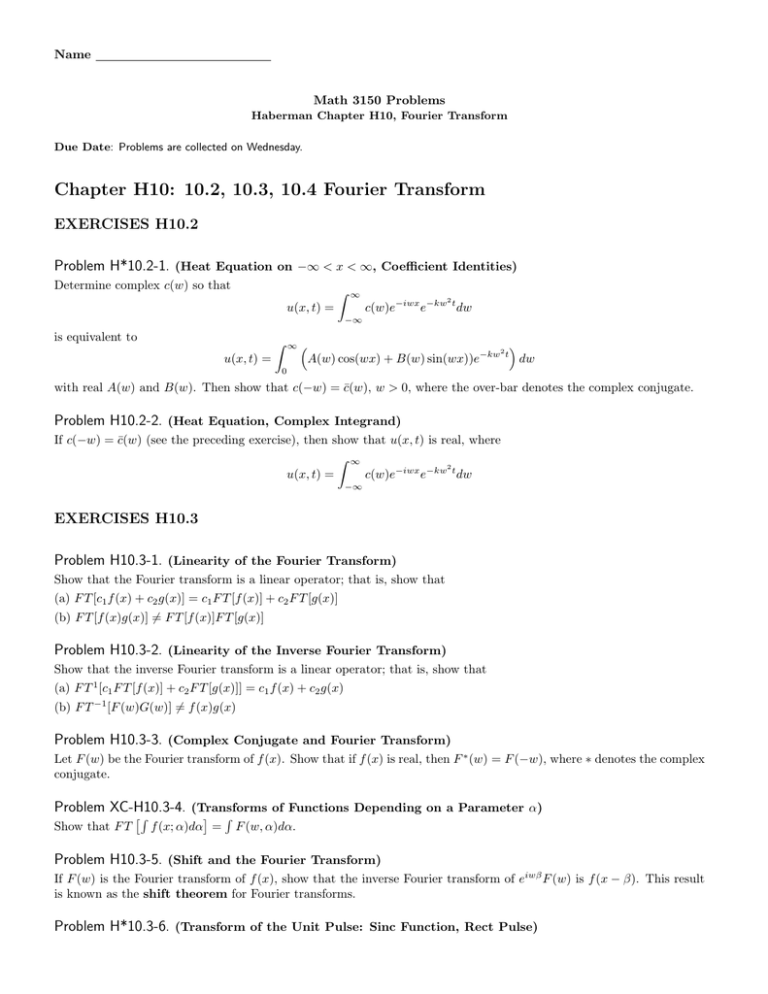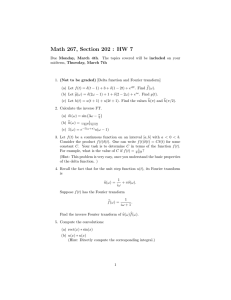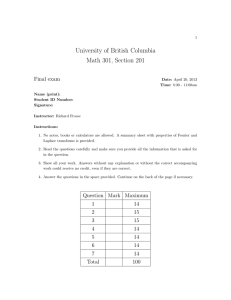Chapter H10: 10.2, 10.3, 10.4 Fourier Transform EXERCISES H10.2 Problem H*10.2-1
advertisement

Name Math 3150 Problems Haberman Chapter H10, Fourier Transform Due Date: Problems are collected on Wednesday. Chapter H10: 10.2, 10.3, 10.4 Fourier Transform EXERCISES H10.2 Problem H*10.2-1. (Heat Equation on −∞ < x < ∞, Coefficient Identities) Determine complex c(w) so that Z ∞ u(x, t) = 2 c(w)e−iwx e−kw t dw −∞ is equivalent to Z ∞ u(x, t) = A(w) cos(wx) + B(w) sin(wx))e−kw 2 t dw 0 with real A(w) and B(w). Then show that c(−w) = c̄(w), w > 0, where the over-bar denotes the complex conjugate. Problem H10.2-2. (Heat Equation, Complex Integrand) If c(−w) = c̄(w) (see the preceding exercise), then show that u(x, t) is real, where Z ∞ 2 u(x, t) = c(w)e−iwx e−kw t dw −∞ EXERCISES H10.3 Problem H10.3-1. (Linearity of the Fourier Transform) Show that the Fourier transform is a linear operator; that is, show that (a) F T [c1 f (x) + c2 g(x)] = c1 F T [f (x)] + c2 F T [g(x)] (b) F T [f (x)g(x)] 6= F T [f (x)]F T [g(x)] Problem H10.3-2. (Linearity of the Inverse Fourier Transform) Show that the inverse Fourier transform is a linear operator; that is, show that (a) F T 1 [c1 F T [f (x)] + c2 F T [g(x)]] = c1 f (x) + c2 g(x) (b) F T −1 [F (w)G(w)] 6= f (x)g(x) Problem H10.3-3. (Complex Conjugate and Fourier Transform) Let F (w) be the Fourier transform of f (x). Show that if f (x) is real, then F ∗ (w) = F (−w), where ∗ denotes the complex conjugate. Problem XC-H10.3-4. (Transforms of Functions Depending on a Parameter α) Show that F T R R f (x; α)dα = F (w, α)dα. Problem H10.3-5. (Shift and the Fourier Transform) If F (w) is the Fourier transform of f (x), show that the inverse Fourier transform of eiwβ F (w) is f (x − β). This result is known as the shift theorem for Fourier transforms. Problem H*10.3-6. (Transform of the Unit Pulse: Sinc Function, Rect Pulse) If f (x) = 0 |x| > a, 1 |x| < a, then determine the Fourier transform of f (x). a 1 sin(aw) , or sinc(aw). The sinc function is a widely research function in numerical analysis, defined by π w π sin(u) sinc(u) = . u Remark. A standard transform table may contain instead the function rect, a rectangular pulse of width 1 with value 1 1 2 at x = ± 2 . Answer: [The answer is given in the table of Fourier transforms in H10, Section 4.4.] Problem H*10.3-7. (Transform Table, Exponential Transform) If F (w) = e−|w|α , α > 0, then determine the inverse Fourier transform of F (w). 2α Answer: f (x) = F T −1 (F (w)) = 2 . x + α2 [The answer is given in the table of Fourier transforms in H10, Section 4.4.] Problem XC-H10.3-8. (Multiply by x and Differentiation of F (w)) If F (w) is the Fourier transform of f (x), show that −i dF/dw is the Fourier transform of xf (x). Problem XC-H10.3-9. (Textbook Details) (a) Multiply (10.3.6) (assuming that γ = 1) by e−iwx and integrate from −L to L to show that Z L F (w)e−iwx dw = −L 1 2π Z ∞ f (u) −∞ 2 sin(L(u − x)) du. (10.3.13) u−x (b) Derive (10.3.7). For simplicity, assume that f (x) is continuous. [Hints: Let f (u) = f (x) + f (u) − f (x). Use the sine R∞ integral, 0 sins s ds = π2 Integrate (10.3.13) by parts and then take the limit as L → ∞. Problem XC-H10.3-11. (Scaling) (a) If f (x) is a function with unit area, has unit area. R∞ −∞ f (x)dx = 1, show that the scaled and stretched function (1/α)f (x/α) also (b) If F (w) is the Fourier transform of f (x), show that F (αw) is the Fourier transform of (α)f (x/α). (c) Show that part (b) implies that broadly spread functions have sharply peaked Fourier transforms near w = 0, and vice versa. Problem XC-H10.3-13. (Cosine) Evaluate R∞ 0 2 e−kw t cos(wx)dw in the following way. Determine ∂I/∂x, and then integrate by parts. Problem H10.3-14. (Gamma Function) The gamma function r(x) is defined as follows: Z ∞ tx−1 e−t dt. Γ(x) = 0 Show that (a) Γ(1) = 1 (b) Γ(x + 1) = Γ(x) (c) Γ(n + 1) = n! (d) Γ(1/2) = 2 (e) What is Γ(3/2)? 2 R∞ 0 2 e−t dt = √ π Problem XC-H10.3-15. (Gamma Function Properties) (a) Using the definition of the gamma function in the previous Exercise, show that Z ∞ 2 Γ(x) = 2 u2x−1 e−u du. 0 (b) Using double integrals in polar coordinates, show that Γ(z)Γ(1 − z) = [Hint: It is known from complex variables that 2 R π/2 0 π . sin(πz) (tan θ)2x−1 dθ = π sin(πz) .] Problem XC-H*10.3-16. (Gamma Function Identity) Evaluate R∞ 0 n y p e−ky dy in terms of the gamma function (see Exercise 10.3.14). 3






